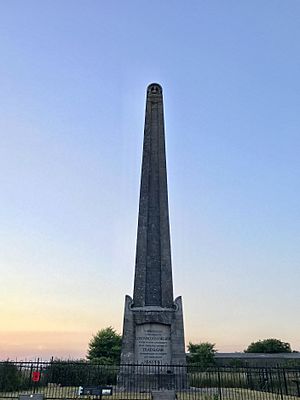Nelson Monument, Portsdown Hill facts for kids
 |
|
| Designer | John Thomas Groves |
|---|---|
| Type | Stele |
| Completion date | 1808 |
| Dedicated to | Horatio Nelson |
The Nelson Monument is a tall stone pillar that stands on Portsdown Hill. This hill is about 2 miles (3.2 km) north of Portsmouth Harbour on the south coast of England. The monument is 120 feet (37 m) tall and sits on a strong granite base.
People wanted to build this monument to remember the amazing victories of the British Navy. They especially wanted to honor Horatio Nelson, a famous naval hero. After Nelson died in the Battle of Trafalgar in 1805, the idea to build a monument became even stronger.
Designing the Monument
A man named John Thomas Groves designed the monument. He worked for the Board of Works. His design was shown at the Royal Academy of Arts in 1807.
Groves got his idea for the monument from the Aksum Stele in Ethiopia. He was inspired by what Henry Salt found in Aksum when he visited Ethiopia in 1805.
Building the Monument
It took a few tries to raise enough money for the monument. The Navy itself finally paid for the project.
Construction of the monument began on July 4, 1807. The final details, like the inscription, were finished just over a year later in 1808.
Modern Use and Location
The monument was rebuilt in 1899, but the bust (a sculpture of Nelson's head and shoulders) at the top is the original one. Today, the monument is still used as a landmark to help ships with their navigation. Sailors use it to check their compasses.
Even though it is very close to the town of Fareham, the monument is actually part of Winchester City Council. Fort Nelson, a nearby fort built in 1871, was named because it is so close to the Nelson Monument. This fort was built when people worried that Napoleon might attack England's south coast.
Images for kids




